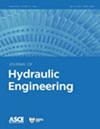求助PDF
{"title":"用于测量河流中悬浮沉积物浓度和粒度分布的流内激光衍射:来自野外运动的见解","authors":"M. Ahammad, J. Czuba, C. Curran","doi":"10.1061/jhend8.hyeng-13232","DOIUrl":null,"url":null,"abstract":": This study evaluates the laser in situ scattering and transmissometry (LISST) instrument LISST-SL2, a laser diffraction instrument for suspended sediment sampling in rivers, with concurrent physical measurements of suspended sediment concentration (SSC) and particle size distribution (PSD) as well as velocity measurements by an acoustic Doppler current profiler (ADCP). We collected 136 LISST-SL2 samples along with 61 physical samples for SSC measurement, of which 24 physical samples included PSD measurement during 2018 – 2020 from 11 sites in Washington state and Virginia. An effective density is required to convert the measured volumetric SSC by the LISST-SL2 into a reported mass SSC, and by default the LISST-SL2 assumes a value of 2 . 65 g = mL. From our data set, we computed effective densities (mass SSC/volumetric SSC) that ranged from 0.5 to 5 . 4 g = mL, with a best-fit value of 2 . 05 g = mL. Additionally, the LISST-SL2 was not able to measure the finest sediment sizes in suspension, which affects the resulting PSD. Therefore, we propose some adjustments of the LISST-SL2 data with a supporting physical sample to account for these effective density and PSD issues. When doing so, we were able to reduce the root-mean square relative error (RMSRE) to 18% from 117% for SSC, and to 26% from 78% for PSD. LISST-SL2 velocities were generally higher than ADCP velocities with a 21% RMSRE. Our results and guidance will allow for more accurate sampling by the LISST-SL2, which has potential for studying spatial and temporal variation of suspended sediment characteristics in rivers. DOI: 10.1061/JHEND8.HYENG-13232. © 2022 American Society of Civil Engineers.","PeriodicalId":16046,"journal":{"name":"Journal of Hydraulic Engineering","volume":" ","pages":""},"PeriodicalIF":2.1000,"publicationDate":"2023-02-01","publicationTypes":"Journal Article","fieldsOfStudy":null,"isOpenAccess":false,"openAccessPdf":"","citationCount":"1","resultStr":"{\"title\":\"In-Stream Laser Diffraction for Measuring Suspended Sediment Concentration and Particle Size Distribution in Rivers: Insights from Field Campaigns\",\"authors\":\"M. Ahammad, J. Czuba, C. Curran\",\"doi\":\"10.1061/jhend8.hyeng-13232\",\"DOIUrl\":null,\"url\":null,\"abstract\":\": This study evaluates the laser in situ scattering and transmissometry (LISST) instrument LISST-SL2, a laser diffraction instrument for suspended sediment sampling in rivers, with concurrent physical measurements of suspended sediment concentration (SSC) and particle size distribution (PSD) as well as velocity measurements by an acoustic Doppler current profiler (ADCP). We collected 136 LISST-SL2 samples along with 61 physical samples for SSC measurement, of which 24 physical samples included PSD measurement during 2018 – 2020 from 11 sites in Washington state and Virginia. An effective density is required to convert the measured volumetric SSC by the LISST-SL2 into a reported mass SSC, and by default the LISST-SL2 assumes a value of 2 . 65 g = mL. From our data set, we computed effective densities (mass SSC/volumetric SSC) that ranged from 0.5 to 5 . 4 g = mL, with a best-fit value of 2 . 05 g = mL. Additionally, the LISST-SL2 was not able to measure the finest sediment sizes in suspension, which affects the resulting PSD. Therefore, we propose some adjustments of the LISST-SL2 data with a supporting physical sample to account for these effective density and PSD issues. When doing so, we were able to reduce the root-mean square relative error (RMSRE) to 18% from 117% for SSC, and to 26% from 78% for PSD. LISST-SL2 velocities were generally higher than ADCP velocities with a 21% RMSRE. Our results and guidance will allow for more accurate sampling by the LISST-SL2, which has potential for studying spatial and temporal variation of suspended sediment characteristics in rivers. DOI: 10.1061/JHEND8.HYENG-13232. © 2022 American Society of Civil Engineers.\",\"PeriodicalId\":16046,\"journal\":{\"name\":\"Journal of Hydraulic Engineering\",\"volume\":\" \",\"pages\":\"\"},\"PeriodicalIF\":2.1000,\"publicationDate\":\"2023-02-01\",\"publicationTypes\":\"Journal Article\",\"fieldsOfStudy\":null,\"isOpenAccess\":false,\"openAccessPdf\":\"\",\"citationCount\":\"1\",\"resultStr\":null,\"platform\":\"Semanticscholar\",\"paperid\":null,\"PeriodicalName\":\"Journal of Hydraulic Engineering\",\"FirstCategoryId\":\"5\",\"ListUrlMain\":\"https://doi.org/10.1061/jhend8.hyeng-13232\",\"RegionNum\":3,\"RegionCategory\":\"工程技术\",\"ArticlePicture\":[],\"TitleCN\":null,\"AbstractTextCN\":null,\"PMCID\":null,\"EPubDate\":\"\",\"PubModel\":\"\",\"JCR\":\"Q2\",\"JCRName\":\"ENGINEERING, CIVIL\",\"Score\":null,\"Total\":0}","platform":"Semanticscholar","paperid":null,"PeriodicalName":"Journal of Hydraulic Engineering","FirstCategoryId":"5","ListUrlMain":"https://doi.org/10.1061/jhend8.hyeng-13232","RegionNum":3,"RegionCategory":"工程技术","ArticlePicture":[],"TitleCN":null,"AbstractTextCN":null,"PMCID":null,"EPubDate":"","PubModel":"","JCR":"Q2","JCRName":"ENGINEERING, CIVIL","Score":null,"Total":0}
引用次数: 1
引用
批量引用
In-Stream Laser Diffraction for Measuring Suspended Sediment Concentration and Particle Size Distribution in Rivers: Insights from Field Campaigns
: This study evaluates the laser in situ scattering and transmissometry (LISST) instrument LISST-SL2, a laser diffraction instrument for suspended sediment sampling in rivers, with concurrent physical measurements of suspended sediment concentration (SSC) and particle size distribution (PSD) as well as velocity measurements by an acoustic Doppler current profiler (ADCP). We collected 136 LISST-SL2 samples along with 61 physical samples for SSC measurement, of which 24 physical samples included PSD measurement during 2018 – 2020 from 11 sites in Washington state and Virginia. An effective density is required to convert the measured volumetric SSC by the LISST-SL2 into a reported mass SSC, and by default the LISST-SL2 assumes a value of 2 . 65 g = mL. From our data set, we computed effective densities (mass SSC/volumetric SSC) that ranged from 0.5 to 5 . 4 g = mL, with a best-fit value of 2 . 05 g = mL. Additionally, the LISST-SL2 was not able to measure the finest sediment sizes in suspension, which affects the resulting PSD. Therefore, we propose some adjustments of the LISST-SL2 data with a supporting physical sample to account for these effective density and PSD issues. When doing so, we were able to reduce the root-mean square relative error (RMSRE) to 18% from 117% for SSC, and to 26% from 78% for PSD. LISST-SL2 velocities were generally higher than ADCP velocities with a 21% RMSRE. Our results and guidance will allow for more accurate sampling by the LISST-SL2, which has potential for studying spatial and temporal variation of suspended sediment characteristics in rivers. DOI: 10.1061/JHEND8.HYENG-13232. © 2022 American Society of Civil Engineers.


